This blog post stemmed from a conversation with Jeff Hopkins, the founder of the Pacific School of Innovation and Inquiry (PSII).
The Un-Learning Process
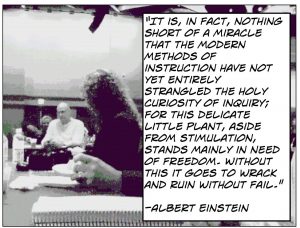
“Educational Quote: “Albert Einstein says…”” by Ken Whytock is licensed under CC BY-NC 2.0
Below are my thoughts on the student transition from public school to PSII.
PSII’s core values encompass a very learner centred learning area such as Open Inquiry, Emergent Curriculum, Learning Happens Everywhere, Learning vs. Learning About, and Co-Construction of learning.
Questions for Jeff and the students at PSII
During our chat, a few thoughts came up that I would like to ask Jeff, students at PSII, or other teachers at the school.
- What made you decide to come to PSII? (this would be for the student)
- What are common paths your students take after graduation? Are there any unique paths students have taken as a result of going to PSII?
- What challenges do students face switching from the public school system to PSII? Challenges if they switch back to public?
- What level of parental support is expected for students? How to do you respond to little or no parental interest in their child’s learning?
- Is there a limit to tapping into free mentor support and how do you check for reliability of mentor? Does it compromise the value of education and teachers?
- Do you have or have you had any First Nations teachers? Students? How do you incorporate or encourage the incorporation of First Nations values / ways of knowing into students’ projects?
- Could a remote access student or teacher attend or teach at PSII?
How to bring inquiry and collaboration into my classroom
PSII values collaboration, cross-curricular, and cross-grade projects and learning; this is why the school limits the number of students each year. A smaller class size allows for more personalized learning and for students to work together in a meaningful way inside and outside of school. Throughout our conversation with Jeff, he stressed that this model isn’t very effective in public schools because of a larger student body.
This got me thinking – if we can’t change the number of students in our schools, could we change our classroom layout to increase student interaction and small group conversation?
Reimagining Classrooms: Teachers as Learners and Students as Leaders | Kayla Delzer | TEDxFargo
Why do some classrooms look the same now as they did 70 years ago? In this passionate talk, second grade teacher Kayla Delzer speaks about her mission to revitalize learning and the classroom environment.
Classroom layout
Your classroom design and layout should have a positive impact on student learning, performance, and collaboration while helping to reduce anxiety of being in a group setting. An ideal classroom should offer private spaces for individual work, and group spaces for conversation and collaboration.
“The purpose of a design is to facilitate and enhance the enactment, continuance, and completion of activities appropriate to the setting the design exemplifies…”
“Classroom layouts should work towards enhancing the enactment, continuation, and completion of activities to reach specific educational goals.”
(Amedeo, D., 2003) Source
Throughout the years, classroom layouts have changed very little, whereas the office space has been completely redesigned in the past quarter-century. Many offices offer private meeting rooms, hang-out areas with ping pong tables or snacks, and large collaborative space with video conferencing facilities. We have made adaptations for the changing business world, but what changes have we made in our classrooms?
Classic Classroom Configurations
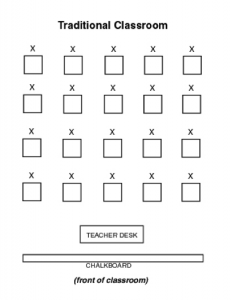
Source: https://www.researchgate.net/figure/Comparison-of-traditional-Thai-classroom-layout-to-the-setup-of-the-learning-incubator_fig3_264817956
The traditional row and column style with all seats facing the front lends itself to ‘sit-and-listen teaching.’

Source: https://www.dallasmidwest.com/blog/classroom-arrangement-tips
Clusters work best for group work, where students share tasks and cooperate.
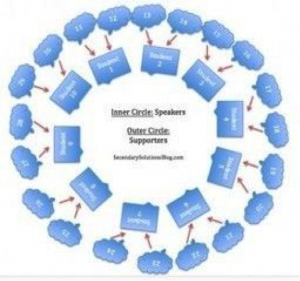
Source: www.betterlesson.com
In a Socratic Seminar, students help one another understand the ideas, issues, and values reflected in a text through a group discussion format.
A Dynamic Classroom for All Types of Learning
The ideal classroom gives space for all types of learning. There should be group space to collaborate, private areas for individual work, large workspaces for projects and hands-on learning, and an array of seating, lighting, and spaces for students to work. It is important for each teacher to think about who they are teaching, what they are teaching, and how to arrange their classroom to meets their teaching needs.
This may may sound like a large list of requirements, but below I have designed a classroom layout which fits all of these needs.
There are group tables for collaboration, an area with computers, and lots of seating for individual work. Rugs, beanbag chairs, tables, chairs, desks, the floor, or in a cubby in the bookshelf are all work spaces the students can choose. A large kidney shaped table is ideal for hands-on activities as well as tables which can be rearranged for larger workspaces. A projector and TV allow for video conferencing between students and other people in the global community, as well as enough computers for each student. Lots of natural light and direct access to the outdoors helps students feel connected to their natural environment as well.
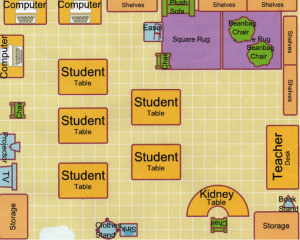
The Ideal Classroom Layout (CC: Hayley Atkins, 2019)
It is useful to think about how we would design our ideal classrooms, and how to best arrange each classroom to meet the needs of students and teachers.
‘The teacher’s educational philosophy will be reflected in the layout of the classroom. The teacher should be able to justify the arrangement of desks and chairs on the basis of certain educational goals. There is no ideal classroom layout for all activities.’ (Sommer, 1977)
Questions to ponder…
When was the last time you looked at your classroom layout from a student perspective?
Do you regularly check if everyone can see and hear properly?
Does the learning activity dictate the seating arrangement in your classroom? Do you change your layout according to different activities or at different times of the year?
Can you justify your choice of classroom seating arrangement on the basis of educational goals?
Here are the main factors you should consider in your classroom in terms of layout:
- Seating
- Place(s) of instruction
- Technology
- Storage
- Decor/Displays
- Flexibility
- Size
In reality, teachers face issues of:
- Budget
- Custodial Agreement
- Sharing room(s) with other teachers
- Safety
- Individual student needs
Resources related to classroom layout and active learning
Interesting EdChat conversation about classroom layouts
Mr. Meyer’s Interactive Math Lessons
The top 10 benefits of a flexible classroom
21st Century Classrooms May Remind you of Starbucks
Action Based Learning Research
Holly Class enjoyed an outdoor arithmetic relay this morning! They competed in teams answering a range of tricky maths calculations. Fantastic cooperation and concentration, Holly Class! #activelearning @HullActiveSch @YHCLT1 pic.twitter.com/TQ0A2LaZSc
— Priory Primary (@priory_primary) July 12, 2019
With active learning, outcomes are better and the knowledge is retained so that a worker can access, adapt, and apply repeatedly and build upon it. #ActiveLearning https://t.co/3GY3xcKBwu
— Roberto Osorno (@RobertoOsorno3) July 13, 2019
Planning a subject leader day/conference for the next academic year? Alongside our charitable partner @YouthSportTrust, we can deliver active learning workshops and keynotes across the UK free of charge! Drop Sophie an email on sophie@motd.org.uk to find out more! #Activelearning pic.twitter.com/tesyDMtk7T
— Teach Active (@TeachActive) July 13, 2019
A helpful reminder as we head into a new school year! #activelearning #classrooms #teaching pic.twitter.com/NIErADoBGs
— Boys Town Press (@BoysTownPress) July 10, 2019
Toss and add! #activemath pic.twitter.com/yYCY0AVDTn
— Dana DuPre (@lets_du_this) October 18, 2017
Decimal Dash data collection in Milti Math! #RealWorld #activemath #engage109 #wilmot109 pic.twitter.com/SDbWR7nV5X
— Jenny Miltimore (@jlmilti) September 28, 2018
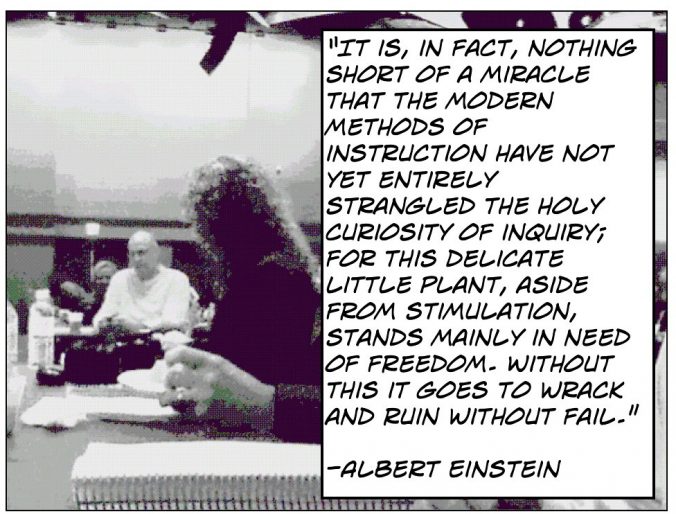
Interesting thoughts about class layout and design. We brought Kim Barthel up the last few years. She is an amazing speaker, with a wealth of knowledge and experience. One thing she said, that your post reminded me of, is that if she could change anything about education it would be flexible seating. She truly believes that the environment can have such a huge impact on our children, and by creating an environment that ensures all students have a space to learn in their own style, you will create a much richer learning experience.
We actually had one of our junior high teachers work with a flexible seating arrangement for his students for the last two years. He has had some positive and some negative experiences with it. He will keep his flexible seating, however, which speaks to the positive outweighing the negatives.
I know I never put a lot of thought into my class layout and design, and more allowed the students to develop their own space and layout….with the confines of rectangular desks and chairs. If I make it back into a classroom, I will pay a lot more attention to class layout.
Thanks for sharing your interesting points and resources!
Thank you for your blog post. I love the idea of various seating arrangements. I think you highlight a very important point in that teachers need to consider the space in which students work in. A space can be very indicative of a teachers pedagogy. It’s also important to note (which you touched on) the idea that it has to be purposeful. It shouldn’t simply be pulled off Pinterest to look aesthetically pleasing but instead offer a supportive and collaborative work space.
I visited @deirdrebailey’s classroom in Alberta and she had no teacher desk and no furniture:
https://www.flickr.com/photos/virvine/10337382535/in/datetaken-public/
Something to think about. Also, what if the layout includes learners who cannot stay in the classroom and need quiet space away from class or need to stay home, but need to remain informed and involved in ways that are not physical?
I don’t even know how I ended up here, but I thought this post was great. I don’t know who you are but certainly you are going to a famous blogger if you aren’t already 😉 Cheers!
Like!! Really appreciate you sharing this blog post.Really thank you! Keep writing.